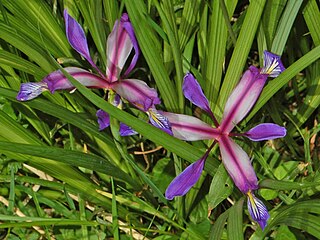
Iris graminea is a species of flowering plant belonging to the subgenus Limniris of the genus Iris, in particular the series Spuriae. It is a rhizomatous perennial, with purple or violet blue flowers almost hidden by narrow, grass-like leaves, and a plum scented fragrance. It is cultivated as an ornamental plant in temperate regions. It has several common names, including grass-leaved flag, grass leaved iris, plum iris and plum tart iris. This species naturally occurs in the southern half of Europe, from Spain and France in the West to Russia and the Caucasus in the East.
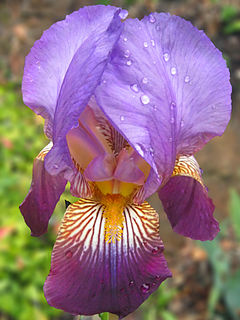
Subgenus Iris is one subgenus of Iris.

Iris aphylla is a species in the genus Iris, it is also in the subgenus Iris, and in the section Iris. It is a rhizomatous perennial, from Asia to Europe. It is found in Azerbaijan, Russian Federation, Czech Republic, Germany, Hungary, Poland, Belarus, Ukraine, Bulgaria, Albania, Former Yugoslavia, Italy, Romania and France. It has dark green or bright green, sword-shaped, long grass-like leaves, that die/fade away in the winter. It also has a slender stem, with several branches and green and purplish spathes. It has 3–5 large flowers, in shades of bright purple, purple, violet, dark blue, blue-violet and dark violet, which bloom between spring and early summer. Occasionally, they re-bloom in the autumn, before the seed capsule is formed. It is cultivated as an ornamental plant in temperate regions. There is one known subspecies Iris aphylla subsp. hungarica Hegi.
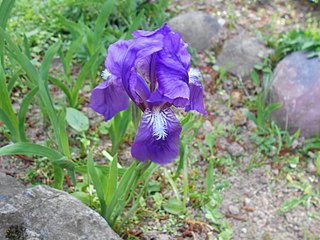
Iris aphylla subsp. hungarica is a plant subspecies in the genus Iris, it is also in the subgenus Iris. It is a subspecies of Iris aphylla. It is a rhizomatous perennial, from the Carpathian Mountains and Pannonian Basin. Found within the countries of Romania, Hungary, Slovakia, Ukraine, Moldova, and Italy. It has curved, pointed, thin leaves, slender stem, several large flowers in shades of purple, or dark purple, or violet-blue. It is a rare plant, that is protected by environmental law in the various countries of Europe.

Iris attica, the Greek iris, is a plant species in the genus Iris, it is also in the subgenus Iris. It is a rhizomatous perennial, from the mountains of the Balkans in Europe, within the countries of Greece, former Yugoslavia, Turkey and North Macedonia. It has sage green or grey-green leaves, that are sickle-shaped, a stout short stem and 2 variable flowers, in shades from yellow to purple. They have a white or blue beard. It is often called Iris pumila subsp attica, but is classified in most sources, as a separate species, although it is closely related to Iris pumila, as a possible parent plant. It is cultivated as an ornamental plant in temperate regions.
Iris adriatica is a plant species in the genus Iris, it is also in the subgenus Iris. It is a rhizomatous perennial, from the Dalmatia region of Croatia in Europe. It has short sickle shaped leaves, small stem and flowers that vary from yellow to purple or violet. It is rarely cultivated as an ornamental plant in temperate regions.
Iris benacensis is a plant species in the genus Iris, it is also in the subgenus Iris. It is a rhizomatous perennial, from Italy. It has similar sized leaves and stem, and blue-purple shaded flowers, that have a white, blue and yellow beard. It was once classified as a synonym of Iris aphylla, before being re-classified as a species in its own right, although some sources still call it a synonym. It is cultivated as an ornamental plant in temperate regions.
Iris cypriana is a plant species in the genus Iris, it is also in the subgenus Iris. It is a rhizomatous perennial, from Cyprus. It has narrow, glaucous and evergreen leaves, tall slender stem, with 2–3 branches, and 1–3 large flowers in lavender, lilac, red-lilac, to dark purple shades. It is cultivated as an ornamental plant in temperate regions. It is listed in some sources as a synonym of Iris germanica.
Iris griffithii is a plant species in the genus Iris, it is also in the subgenus Iris. It is a rhizomatous perennial, from Afghanistan. It has short, sickle-shaped leaves, short green stem and purple flowers with white beards. Several specimens exist within herbaria around Europe, but it is rarely cultivated.

Iris marsica is a plant species in the genus Iris, it is also in the subgenus Iris. It is a rhizomatous perennial, from the Apennine Mountains, in Italy. It has glaucous, sickle-shaped or curved, light green leaves, slender stem with 2 branches, and 3 violet, light blue violet, dark violet, and dark purple flowers. It was only found and described since 1973, and is not yet in general cultivation. It was once thought to be a form of Iris germanica, but has different morphological characteristics and different chromosomal differences.
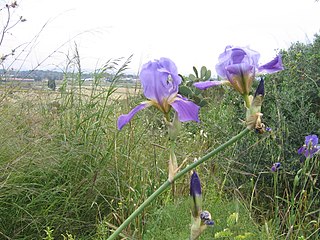
Iris mesopotamica, the Mesopotamian iris, is a species in the genus Iris, it is also in the subgenus Iris. It is a rhizomatous perennial, from the middle East, within the countries of Iraq, Turkey, Syria and Israel. It has linear, grey-green or green broad leaves, tall stem with 2–3 branches, holding up to 9 scented flowers, in shades of violet, purple, lavender blue and light blue, with a yellow and white or orange and white beard. It is listed as a synonym of Iris germanica in some sources. It is cultivated as an ornamental plant in temperate regions, including being planted in graveyards and cemeteries but may also be used for celebrations and decoration.
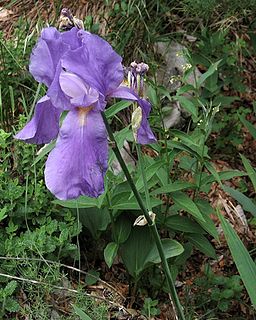
Iris pallida subsp. cengialti is a subspecies in the genus Iris, it is also in the subgenus Iris. It is a rhizomatous perennial, from Italy and Slovenia. It has yellowish-green, glaucous, lanceolate or ensiform leaves, tall stem, green flushed with purple spathes, 2 short branches, 2–3 scented flowers, in shades of violet, blue-violet, deep purple, blue-purple, deep blue-purple, pale purple, deep blue, to mid-blue. It has a yellow or orange tipped beard. It was originally published as Iris cengialti but then re-classified as a subspecies of Iris pallida, and known as Iris pallida subsp. cengialti, but it is often still called Iris cengialti. It is cultivated as an ornamental garden plant in temperate regions.
Iris perrieri is a plant species in the genus Iris; it is also in the subgenus Iris. It is a rhizomatous perennial, from the Savoy Alps in southern France and recently in Italy. It has green, deeply ribbed, sickle shaped leaves, a slender stem with a branch, 1–3 scented flowers that are violet or purple, with a white or pale blue beard. It is rarely cultivated as an ornamental plant in temperate regions, due to its rarity in the wild. It was once thought to be a form of Iris aphylla, before cell (chromosome) analysis determined it to be a separate species.
Iris relicta is a plant species in the genus Iris, it is also in the subgenus Iris. It is a rare rhizomatous perennial, from the mountains of Italy. It is medium-sized, with purple flowers and white beards. It is rarely cultivated as an ornamental plant in temperate regions. It has had a confusing history, once thought as a variety of Iris germanica, then as a separate species with a name shared with another bearded iris. It has only been sorted out since 1996.
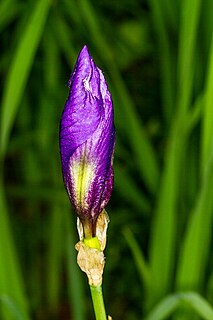
Iris sambucina, the elder scented iris, is a plant species in the genus Iris, it is also in the subgenus Iris. It is a rhizomatous perennial, from southern and central Europe, and Spain. It has green, curved or sword-like leaves, tall round stem, multiple flowers in shades from brown violet, or brown-purple, to purple-violet, blue violet, mauve, and to purple. The large flowers are fragrant, with the scent of elderflowers, hence the name. It was first considered a separate species, then it was classified as a synonym of Iris germanica, before being classified as a separate species again, but with a hybrid origin from Iris pallida and Iris variegata. It is sometimes cultivated as an ornamental plant in temperate regions.
Iris revoluta is a plant species in the genus Iris, it is also in the subgenus Iris. It is a rhizomatous perennial, from a small area in Salento, Italy. It has (sword-shaped) or falcate (sickle-shaped) glaucous leaves, tall slender stem with several short branches and 2–4 fragrant flowers in dark violet, purple, violet and pale violet. It is rarely cultivated as an ornamental plant in temperate regions.
Iris setina, the iris of Sezze, is a species in the genus Iris, it is also in the subgenus of Iris. It is a rhizomatous perennial, from a small region in Italy.It has glaucous sword-like leaves, slender branched stem, and one or two violet toned flowers. It is not yet cultivated as an ornamental plant in temperate regions.

Iris suaveolens is a plant species in the genus Iris, it is also in the subgenus Iris. It is a rhizomatous perennial, from Eastern Europe, ranging from the Balkans to Turkey. It has short, sickle shaped or curved, blue-green or greyish green leaves, a slender simple stem, with 1 or 2 fragrant spring blooming, flowers, between yellow and purple, with white or yellow beards. It was once known as Iris mellita, until that was re-classified as a synonym of Iris suaveolens. It is cultivated as an ornamental plant in temperate regions.

Iris subbiflora is a plant species in the genus Iris, it is also in the subgenus Iris. It is a rhizomatous perennial, from Portugal and Spain in Europe. It has evergreen broad leaves, forming dense clumps, it has dwarf stems in late spring,, with 1 upright fragrant flower, in shades of purple, light red purple, grey-blue, blue-violet, or dark violet. It has a beard which is generally blue, purple, or violet, but can fade to white, dull yellow, or dark yellow. After being found in 1804, it was once a separate species until the late 70s, when it was reclassified as subspecies of Iris lutescens, and renamed Iris lutescens subsp. subbiflora. But in the 80s it was returned to an independent species but some authors and references still class the species as a synonym or subspecies. It is cultivated as an ornamental plant in temperate regions.
Iris timofejewii is a species of flowering plant in the genus Iris, and also in the subgenus Iris. It is a rhizomatous perennial, from the mountain slopes of the Caucasus and Dagestan. It has narrow, evergreen, falcate (sickle-shaped), grey-green (glaucous) leaves, and a short flowering stem just taller than the leaves. Each stem has 1–2 flowers in shades of violet, with white beards that have purple tips. It is cultivated as an ornamental plant in temperate regions.










